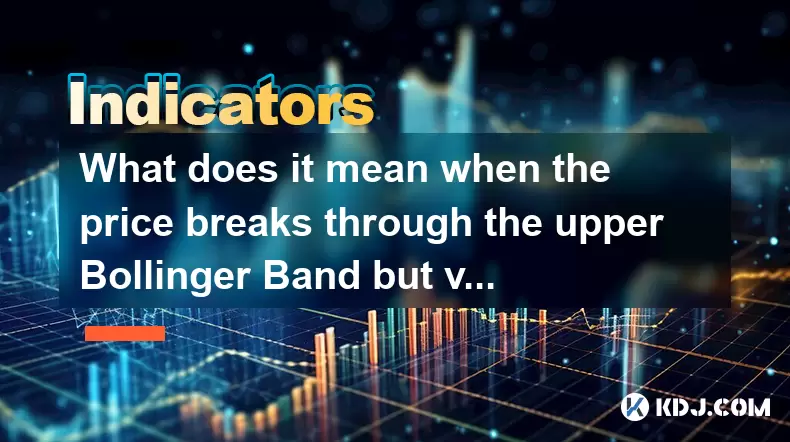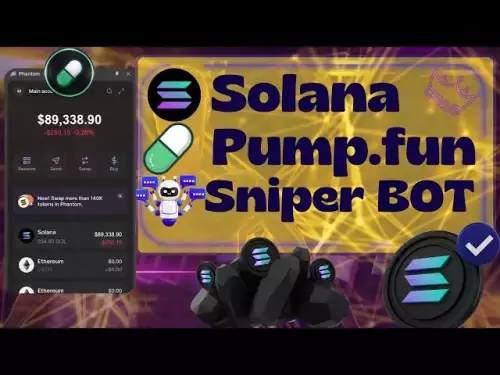-
 Bitcoin
Bitcoin $115100
-1.30% -
 Ethereum
Ethereum $4758
-1.70% -
 XRP
XRP $3.027
-2.19% -
 Tether USDt
Tether USDt $0.9998
-0.01% -
 BNB
BNB $883.2
-1.42% -
 Solana
Solana $204.0
2.62% -
 USDC
USDC $1.000
0.02% -
 Dogecoin
Dogecoin $0.2371
-0.97% -
 TRON
TRON $0.3612
-1.24% -
 Cardano
Cardano $0.9128
-2.19% -
 Chainlink
Chainlink $26.13
-3.93% -
 Hyperliquid
Hyperliquid $44.73
0.90% -
 Sui
Sui $3.715
-0.56% -
 Stellar
Stellar $0.4153
-2.41% -
 Ethena USDe
Ethena USDe $1.000
-0.04% -
 Bitcoin Cash
Bitcoin Cash $588.9
-2.06% -
 Avalanche
Avalanche $25.91
3.27% -
 Hedera
Hedera $0.2525
-1.45% -
 Litecoin
Litecoin $120.9
-1.35% -
 UNUS SED LEO
UNUS SED LEO $9.607
0.30% -
 Toncoin
Toncoin $3.382
-0.31% -
 Shiba Inu
Shiba Inu $0.00001329
-0.38% -
 Uniswap
Uniswap $11.38
-1.67% -
 Polkadot
Polkadot $4.222
2.83% -
 Aave
Aave $354.5
4.93% -
 Dai
Dai $0.0000
0.00% -
 Bitget Token
Bitget Token $4.704
-1.49% -
 Cronos
Cronos $0.1565
1.83% -
 Ethena
Ethena $0.7463
1.55% -
 Monero
Monero $265.8
-0.39%
What does it mean when the price breaks through the upper Bollinger Band but volume doesn't increase?
A price breakout above the upper Bollinger Band without rising volume may signal a false move, especially in volatile crypto markets like DOGE or SHIB, where manipulation is common.
Aug 13, 2025 at 11:36 am

Understanding Bollinger Bands and Their Structure
Bollinger Bands are a widely used technical analysis tool developed by John Bollinger. They consist of three lines plotted on a price chart: the middle band, which is typically a 20-period simple moving average (SMA); the upper band, which is the middle band plus two standard deviations; and the lower band, which is the middle band minus two standard deviations. These bands dynamically expand and contract based on market volatility. When volatility increases, the bands widen; when volatility decreases, they narrow. Traders often interpret price touching or crossing the upper band as a sign of overbought conditions, though this is not a definitive signal of reversal on its own.
The upper Bollinger Band acts as a dynamic resistance level. A price breaking through this band suggests strong upward momentum. However, the interpretation of such a breakout depends heavily on accompanying indicators, especially volume. Volume reflects the number of shares or contracts traded over a given period and is considered a confirmation tool for price movements. A breakout with high volume typically indicates strong conviction among traders, whereas a breakout with flat or declining volume may suggest weakness or lack of participation.
Interpreting a Price Break Above the Upper Band
When the price breaks through the upper Bollinger Band, it signals that the asset is trading significantly above its recent average price. This can occur during strong bullish momentum, news-driven rallies, or speculative surges. In the cryptocurrency market, such breakouts are common due to the high volatility of digital assets. However, not all breakouts are equal. A breakout supported by rising trading volume implies that a large number of participants are buying, increasing the reliability of the move. Conversely, a breakout without volume support raises questions about the sustainability of the upward move.
In many cases, a price surge into the upper band without volume confirmation may indicate short-covering, whale manipulation, or algorithmic trading spikes rather than broad market participation. For instance, in markets like Bitcoin or Ethereum, a sudden price jump caused by a few large transactions may push the price above the upper band, but if retail and institutional traders are not actively participating, the move lacks depth. This discrepancy between price action and volume can be a red flag for traders relying on volume as a confirmation signal.
Why Volume Matters in Breakout Validation
Volume is a critical component in validating any technical breakout. A genuine breakout should ideally be accompanied by a noticeable increase in trading volume. This increase confirms that the price movement is driven by significant market interest rather than isolated trades. In the absence of higher volume, the breakout may be considered a false breakout or a bull trap.
- High volume during a breakout suggests strong demand and increased buying pressure.
- Low or flat volume during a breakout may indicate a lack of conviction among market participants.
- Declining volume while price rises could signal weakening momentum and potential exhaustion.
In cryptocurrency trading, where markets operate 24/7 and are susceptible to pump-and-dump schemes, volume analysis becomes even more crucial. For example, if BNB breaks above its upper Bollinger Band on a major exchange but the trading volume remains unchanged, it could be the result of a coordinated buy wall rather than organic demand. Traders using technical analysis platforms like TradingView can overlay volume indicators to assess whether the breakout has legitimacy.
Strategies for Trading a Volume-Less Upper Band Breakout
When the price breaks through the upper Bollinger Band without a corresponding rise in volume, traders should exercise caution. Several strategies can be employed to manage risk and avoid false signals:
- Wait for confirmation: Do not enter a long position immediately. Instead, wait for the next candle to close above the band with rising volume.
- Use additional indicators: Combine Bollinger Bands with tools like Relative Strength Index (RSI) or MACD to check for overbought conditions or divergence.
- Set tight stop-loss orders: If entering a trade, place a stop-loss just below the breakout point to limit downside risk.
- Monitor order book depth: On exchanges like Binance or Bybit, examine the order book to see if the breakout is supported by real buy orders or just market orders consuming liquidity.
For example, if Solana (SOL) breaks above its upper Bollinger Band but the volume remains flat, a trader might look at the RSI. If the RSI is above 70, it confirms overbought conditions, increasing the likelihood of a pullback. This multi-indicator approach helps filter out noise and improves decision-making accuracy.
Historical Examples in Cryptocurrency Markets
There have been numerous instances in the crypto market where price broke the upper Bollinger Band without volume support, leading to sharp reversals. One notable example occurred in Dogecoin (DOGE) during early 2021. The price surged past the upper band due to social media hype, but volume failed to increase proportionally. Within hours, the price reversed and fell back inside the bands, trapping late buyers.
Another case involved Cardano (ADA) in late 2022. ADA briefly broke above its upper Bollinger Band on a regional exchange, but volume remained stagnant. The move was later attributed to a large whale placing a single buy order. Once the order was filled, price quickly reverted. These examples highlight the importance of volume confirmation in volatile crypto markets where manipulation is more prevalent than in traditional financial markets.
Frequently Asked Questions
Can a breakout above the upper Bollinger Band still be valid without high volume?
Yes, but it is considered less reliable. While price can technically break out, the absence of volume suggests limited market participation. Such breakouts often fail or retrace quickly, especially in low-liquidity altcoins.
What should I do if I already entered a trade during a low-volume breakout?
Monitor the next few candlesticks closely. If volume begins to rise and price continues upward, the trade may still be valid. If volume remains flat and price stalls or forms a bearish candle pattern, consider exiting to protect profits or limit losses.
Does the time frame affect the significance of volume in Bollinger Band breakouts?
Absolutely. On shorter time frames like 5-minute or 15-minute charts, volume spikes can be erratic. On daily or weekly charts, volume trends carry more weight. A breakout on a daily chart without volume support is a stronger warning sign than on a 1-minute chart.
Are there specific cryptocurrencies where volume-less breakouts are more common?
Yes, low-market-cap altcoins and memecoins such as Shiba Inu (SHIB) or Pepe (PEPE) often experience volume-less breakouts due to low liquidity and high susceptibility to whale manipulation. Major coins like Bitcoin and Ethereum tend to have more reliable volume-price correlations.
Disclaimer:info@kdj.com
The information provided is not trading advice. kdj.com does not assume any responsibility for any investments made based on the information provided in this article. Cryptocurrencies are highly volatile and it is highly recommended that you invest with caution after thorough research!
If you believe that the content used on this website infringes your copyright, please contact us immediately (info@kdj.com) and we will delete it promptly.
- Crypto, Pepe, and Investment: Navigating the Meme Coin Mania in 2025
- 2025-08-24 06:45:29
- Crypto Market Recovery: Unearthing ROI Gems in 2025
- 2025-08-24 05:25:35
- Aave, World Liberty, and Token Allocation: Decoding the DeFi Buzz
- 2025-08-24 05:25:35
- Crypto Presales & Exchange Launches: What's Hot Now?
- 2025-08-24 05:45:17
- Meme Coin Mania: Experts Rank Layer Brett as the Top Contender
- 2025-08-24 05:45:18
- Sui Price Prediction: Will the Breakout Move Stick?
- 2025-08-24 06:05:29
Related knowledge

What does it mean when the +DI and -DI cross frequently in the DMI indicator but the ADX is flattening?
Aug 11,2025 at 03:15am
Understanding the DMI Indicator ComponentsThe Directional Movement Index (DMI) is a technical analysis tool composed of three lines: the +DI (Positive...

What does the sudden appearance of a "dark cloud cover" candlestick pattern during an uptrend indicate?
Aug 13,2025 at 11:35am
Understanding the 'Dark Cloud Cover' Candlestick PatternThe dark cloud cover is a bearish reversal pattern in technical analysis that typically appear...

What does it mean when the moving average, MACD, and RSI all send buy signals simultaneously?
Aug 11,2025 at 01:42pm
Understanding the Convergence of Technical IndicatorsWhen the moving average, MACD, and RSI all generate buy signals at the same time, traders interpr...

What does it mean when both the KDJ indicator and the RSI show overbought signals simultaneously?
Aug 13,2025 at 11:35am
Understanding the KDJ Indicator in Cryptocurrency TradingThe KDJ indicator is a momentum oscillator derived from the Stochastic Oscillator, widely use...

What does it mean when the price is trading above the SAR indicator but the red dots are densely packed?
Aug 09,2025 at 11:49pm
Understanding the SAR Indicator and Its Visual SignalsThe SAR (Parabolic Stop and Reverse) indicator is a technical analysis tool used primarily to de...

What does it mean when the candlestick chart forms a "Morning Star" but trading volume is sluggish?
Aug 12,2025 at 06:28pm
Understanding the Morning Star Candlestick PatternThe Morning Star is a three-candle bullish reversal pattern commonly observed in cryptocurrency pric...

What does it mean when the +DI and -DI cross frequently in the DMI indicator but the ADX is flattening?
Aug 11,2025 at 03:15am
Understanding the DMI Indicator ComponentsThe Directional Movement Index (DMI) is a technical analysis tool composed of three lines: the +DI (Positive...

What does the sudden appearance of a "dark cloud cover" candlestick pattern during an uptrend indicate?
Aug 13,2025 at 11:35am
Understanding the 'Dark Cloud Cover' Candlestick PatternThe dark cloud cover is a bearish reversal pattern in technical analysis that typically appear...

What does it mean when the moving average, MACD, and RSI all send buy signals simultaneously?
Aug 11,2025 at 01:42pm
Understanding the Convergence of Technical IndicatorsWhen the moving average, MACD, and RSI all generate buy signals at the same time, traders interpr...

What does it mean when both the KDJ indicator and the RSI show overbought signals simultaneously?
Aug 13,2025 at 11:35am
Understanding the KDJ Indicator in Cryptocurrency TradingThe KDJ indicator is a momentum oscillator derived from the Stochastic Oscillator, widely use...

What does it mean when the price is trading above the SAR indicator but the red dots are densely packed?
Aug 09,2025 at 11:49pm
Understanding the SAR Indicator and Its Visual SignalsThe SAR (Parabolic Stop and Reverse) indicator is a technical analysis tool used primarily to de...

What does it mean when the candlestick chart forms a "Morning Star" but trading volume is sluggish?
Aug 12,2025 at 06:28pm
Understanding the Morning Star Candlestick PatternThe Morning Star is a three-candle bullish reversal pattern commonly observed in cryptocurrency pric...
See all articles

























































































